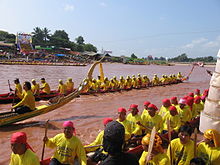Nan River
| Nan River | |
|---|---|
Nan Province | |
| • coordinates | 19°20′0″N 101°12′0″E / 19.33333°N 101.20000°E |
| • elevation | 1,240 m (4,070 ft) |
Nakhon Sawan | |
• coordinates | 15°42′04″N 100°08′31″E / 15.701°N 100.142°E |
• elevation | 25 m (82 ft) |
| Length | 740 km (460 mi)[1] |
| Basin size | 57,947 km2 (22,373 sq mi) |
| Discharge | |
| • location | Nakhon Sawan[2] |
| • average | 472 m3/s (16,700 cu ft/s) |
| • maximum | 1,522 m3/s (53,700 cu ft/s) |
| Basin features | |
| Tributaries | |
| • left | Khwae Noi River, Wang Thong River |
| • right | Yom River |
The Nan River (

Geography
The Nan River originates in the
Tributaries
The chief tributary of the Nan is the Yom River, which joins the Nan in Chum Saeng District in Nakhon Sawan Province. Other direct tributaries include
Waterfalls
Kaeng Luang is a waterfall on the Nan River in Nan Province.[3]
Drainage
Greater Nan Basin

The expanse of the Nan River's tributaries, i.e. the Nan River System, together with the land upon which falling rain drains into these bodies of water, form the Greater Nan Drainage Basin, which is part of the Chao Phraya watershed.[4] The total area drained by the Nan and its tributaries is 57,947 square kilometres (22,373 sq mi). Much of the lower basin has perfect soil for farming.
Nan Basin
Most drainage analyses, however, divide the Greater Nan Basin into the Nan Basin and the Yom River Basin. Using this convention, and subtracting the 23,616 square kilometres (9,118 sq mi) of land drained by the Yom and its tributaries, the Nan basin drains a total of 34,331 square kilometres (13,255 sq mi) of land in the provinces of Phitsanulok, Phichit, Nan and Uttaradit.
History
Early civilizations
Ancient civilizations lived in the fertile land along the Nan River and its tributaries, as is evidenced by
Houseboats

Phitsanulok is the only place in Thailand where houseboats are legal, as they have been an important aspect of regional culture since long before the drafting of modern municipal law. People of Phitsanulok still gather on houseboats and raft houses along both sides of the Nan River in the city, and adhere to a traditional way of life.[6] There is even a floating houseboat museum along the Nan in Phitsanulok, which allows tourists to experience the Nan houseboat culture first-hand.
Naresuan Dam
The Naresuan Dam, named after King Naresuan, was constructed throughout the span of 1976 through 1985 on the Nan River in Phitsanulok Province, north of the city of Phitsanulok, as part of the Phitsanulok Irrigation Project.[7]
Pollution
Water quality in the Nan River is deteriorating from heavy
References
- ^ "Longest Rivers in Thailand". 25 April 2017.
- ^ Discharge locations [dead link]
- ^ Lonely Planet Thailand, Vietnam, Laos & Cambodia Road Atlas
- ^ a b "River and Watershed Facts on the Chao Phraya". Archived from the original on 2009-01-04. Retrieved 2007-10-10.
- ^ ISBN 978-0-521-01647-6A History of Thailand
- ^ Phitsanulok on ThaiWebsites.com
- ^ Phitsanulok Irrigation Project Archived 2008-05-03 at the Wayback Machine
External links
- Barr, Sandra M.; Alan. S. Macdonald (October 1987). "Nan River suture zone, northern Thailand". .
